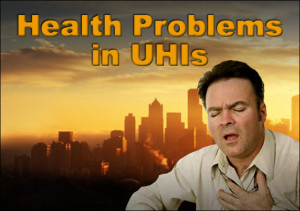The Health Problems Caused by Sizzling Summer Heat in the Cities
 The urban heat island (UHI) phenomena causes scorching temperatures every summer in many major U.S. cities. This sweltering summer heat makes cities uncomfortable, energy draining, unhealthy— and deadly.
The urban heat island (UHI) phenomena causes scorching temperatures every summer in many major U.S. cities. This sweltering summer heat makes cities uncomfortable, energy draining, unhealthy— and deadly.
Health Consequences of Urban Heat Islands
Summer heat is absorbed and magnified by the city infrastructure. Relentless temperatures promote asthma attacks, respiratory problems, heart attacks, heat cramps, heat exhaustion, and heat stroke in overheated city dwellers. The heat also kills.
Consider these UHI facts:
- The Centers for Disease Control (CDC) estimates excessive heat exposure contributed to 8,000 deaths in the U.S. from 1979-2003.
- Heat is America’s number one weather-related killer. Excessive heat kills more people in the U.S. each year than earthquakes, floods, hurricanes, lightning, and tornadoes combined, according to the National Oceanic and Atmospheric Administration (NOAA).
- On average, almost 700 Americans die each year from heat-induced illnesses, according to the CDC.
- In one excruciating week during the summer of 1995, an oppressive heat wave rocked Chicago. The heat index rose to 120°F. City roads buckled. Train rails warped. Energy use skyrocketed. Power grids failed. Thousands developed heat-related disorders. Over 700 died.
- A crushing heat wave in Paris, France in 2003 killed 4,800 people.
- The elderly and the poor are particularly vulnerable to heat-related premature deaths.
Pollution increases in an urban heat island. Tall buildings block cooling breezes, leaving the over-heated air still and stagnant.
Exhausted, over-heated people seek relief by pushing air conditioning to the limit in business and homes. Power plants struggle to keep up with demand, resulting in the release of more greenhouse gas emissions into the atmosphere. Carbon dioxide flourishes, adding its noxious fumes to the toxic mix. Ground-level ozone forms as volatile organic chemicals (VOCs) react to sunlight and heat. Pollution increases.
Those with respiratory problems are vulnerable to the poor air quality associated with UHIs— especially the very young and the very old. Some evidence suggests the UHI effect increases the pollen count and extends the pollen season, prolonging the suffering of those with allergies and asthma.
According to the CDC, 25 million Americans now suffer from asthma— and that number is increasing. Like asthma, chronic obstructive pulmonary disease (COPD) affects breathing, which is even more difficult during oppressive heat. Over 10 million people in the U.S. have chronic bronchitis.
Saving People, Planet, and Pocketbook
The next part of this series will cover some the environmental problems UHIs cause.
One of the best ways to mitigate the effects of UHIs is to build energy-efficient, environmentally friendly structures in the first place. RHINO Steel Building Systems create structures that offer urban heat island solutions for people, the planet, and pocketbooks.
- RHINO structures contain a high-recycled content.
- The strength of steel— and RHINO’s pre-engineered system— reduces the amount of building material required to frame a structure as it reduces waste.
- RHINO buildings insulated with the Pro-Value system decrease outside noise from penetrating the building envelop— and save up to 50% on heating and air conditioning.
- Cool-coated metal roofing offered by RHINO reflects the sun’s heat away from the building, cutting energy usage as much as 15%.
- As an inorganic material, steel does not promote allergens like wood framing does. Steel will never support mold growth or termites and other vermin.
- RHINO buildings are 100% recyclable at the end of the structure’s lifecycle.
Please call RHINO now at 855.269.3632 to learn more about our earth-friendly building products and urban heat island solutions.
